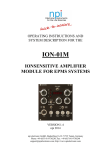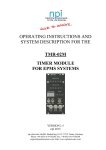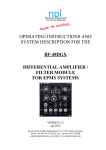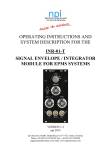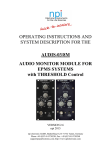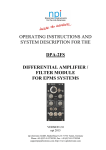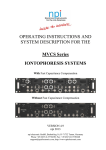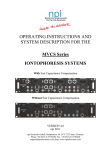Download OPERATING INSTRUCTIONS AND SYSTEM DESCRIPTION FOR
Transcript
OPERATING INSTRUCTIONS AND SYSTEM DESCRIPTION FOR THE HV-TR150 HIGH VOLTAGE TRACER INJECTION MODULE FOR EPMS SYSTEMS VERSION 1.8 npi 2015 npi electronic GmbH, Bauhofring 16, D-71732 Tamm, Germany Phone +49 (0)7141-9730230; Fax: +49 (0)7141-9730240 [email protected]; http://www.npielectronic.com HV-TR150 User Manual _________________________________________________________________________________________________________________ Table of Contents 1. Safety Regulations ............................................................................................................... 3 2. EPMS-07 Modular Plug-In System ..................................................................................... 4 2.1. General System Description / Operation ...................................................................... 4 2.2. EPMS-07 Housing........................................................................................................4 2.3. EPMS-H-07 Housing ................................................................................................... 4 2.4. EPMS-E-07 Housing .................................................................................................... 4 2.5. EPMS-03 ...................................................................................................................... 5 2.6. PWR-03D ..................................................................................................................... 5 3. HV-TR150 Tracer Injection Module ................................................................................... 6 3.1. HV-TR150 Components ..............................................................................................6 3.2. HV-TR150 System Description ...................................................................................6 3.4. Description of the Front Panel .....................................................................................7 3.5. Headstage ..................................................................................................................... 9 3.6. Operation ...................................................................................................................... 10 In combination with an amplifier ................................................................................. 10 As independent iontophoresis amplifier ....................................................................... 11 4. Technical Data ..................................................................................................................... 12 ___________________________________________________________________________ version 1.8 page 2 HV-TR150 User Manual _________________________________________________________________________________________________________________ 1. Safety Regulations VERY IMPORTANT: Instruments and components supplied by npi electronic are NOT intended for clinical use or medical purposes (e.g. for diagnosis or treatment of humans), or for any other life-supporting system. npi electronic disclaims any warranties for such purpose. Equipment supplied by npi electronic must be operated only by selected, trained and adequately instructed personnel. For details please consult the GENERAL TERMS OF DELIVERY AND CONDITIONS OF BUSINESS of npi electronic, D-71732 Tamm, Germany. 1) GENERAL: This system is designed for use in scientific laboratories and must be operated only by trained staff. General safety regulations for operating electrical devices should be followed. 2) AC MAINS CONNECTION: While working with the npi systems, always adhere to the appropriate safety measures for handling electronic devices. Before using any device please read manuals and instructions carefully. The device is to be operated only at 115/230 Volt 60/50 Hz AC. Please check for appropriate line voltage before connecting any system to mains. Always use a three-wire line cord and a mains power-plug with a protection contact connected to ground (protective earth). Before opening the cabinet, unplug the instrument. Unplug the instrument when replacing the fuse or changing line voltage. Replace fuse only with an appropriate specified type. 3) STATIC ELECTRICITY: Electronic equipment is sensitive to static discharges. Some devices such as sensor inputs are equipped with very sensitive FET amplifiers, which can be damaged by electrostatic charge and must therefore be handled with care. Electrostatic discharge can be avoided by touching a grounded metal surface when changing or adjusting sensors. Always turn power off when adding or removing modules, connecting or disconnecting sensors, headstages or other components from the instrument or 19” cabinet. 4) TEMPERATURE DRIFT / WARM-UP TIME: All analog electronic systems are sensitive to temperature changes. Therefore, all electronic instruments containing analog circuits should be used only in a warmed-up condition (i.e. after internal temperature has reached steady-state values). In most cases a warm-up period of 20-30 minutes is sufficient. 5) HANDLING: Please protect the device from moisture, heat, radiation and corrosive chemicals. ___________________________________________________________________________ version 1.8 page 3 HV-TR150 User Manual _________________________________________________________________________________________________________________ 2. EPMS-07 Modular Plug-In System 2.1. General System Description / Operation The npi EPMS-07 is a modular system for processing of bioelectrical signals in electrophysiology. The system is housed in a 19” rack-mount cabinet (3U) has room for up to 7 plug-in units. The plug-in units are connected to power by a bus at the rear panel. The plug-in units must be kept in position by four screws (M 2,5 x 10). The screws are important not only for mechanical stability but also for proper electrical connection to the system housing. Free area must be protected with covers. 2.2. EPMS-07 Housing The following items are shipped with the EPMS-07 housing: EPMS-07 cabinet with built-in power supply Mains cord Fuse 2 A / 1 A, slow (inserted) Front covers Figure 1: Left: front view of empty EPMS-07 housing. In order to avoid induction of electromagnetic noise the power supply unit, the power switch and the fuse are located at the rear of the housing (see Figure 2, right). 2.3. EPMS-H-07 Housing In addition to the standard power supply of the EPMS-07, the EPMS-H-07 has a built-in high voltage power supply. This is necessary for all MVCS / MVCC modules, the HVA-100, HVTR150 and HVC-03M modules. The output voltage depends on the modules in use. 2.4. EPMS-E-07 Housing The following items are shipped with the EPMS-E-07 housing: EPMS-E-07 cabinet External Power supply PWR-03D Power cord (PWR-03D to EPMS-E-07) Mains chord Fuse 1.6 A / 0.8 A, slow (inserted) Front covers ___________________________________________________________________________ version 1.8 page 4 HV-TR150 User Manual _________________________________________________________________________________________________________________ The EPMS-E-07 housing is designed for low-noise operation, especially for extracellular and multi-channel amplifiers with plugged in filters. It operates with an external power supply to minimize distortions of the signals caused by the power supply. 2.5. EPMS-03 The following items are shipped with the EPMS-03 housing: EPMS-03 cabinet with built-in power supply Mains cord Fuse 034 A / 0,2 A, slow (inserted) Front covers Figure 2: Left: front view of EPMS-03 housing. Right: rear panel detail of EPMS-03 and EPMS-07 housing. In order to avoid induction of electromagnetic noise the power supply unit, the power switch and the fuse are located at the rear of the housing (see Figure 2, right). 2.6. PWR-03D The external power supply PWR-03D is capable of driving up to 3 EPMS-E housings. Each housing is connected by a 6-pole cable from one of three connectors on the front panel of the PWR-03D to the rear panel of the respective EPMS-E housing. (see Figure 3, Fehler! Verweisquelle konnte nicht gefunden werden.). A POWER LED indicates that the PWR03D is powered on (see Figure 3, left). Power switch, voltage selector and fuse are located at the rear panel (see Figure 3, right). Note: The chassis of the PWR-03D is connected to protective earth, and it provides protective earth to the EPMS-E housing if connected. Figure 3: Left: PWR-03D front panel view Right: PWR-03D rear panel view. Note: This power supply is intended to be used with npi EPMS-E systems only. ___________________________________________________________________________ version 1.8 page 5 HV-TR150 User Manual _________________________________________________________________________________________________________________ 3. HV-TR150 Tracer Injection Module 3.1. HV-TR150 Components The following items are shipped with the HV-TR150 system: Injection module for the EPMS-07 system Headstage User manual Optional accessories: Electrode holder (see also Figure 5 and Figure 6) 3.2. HV-TR150 System Description The HV-TR150 tracer injector is a plug-in unit for the npi EPMS-H-07 modular system. The HV-TR150 is designed to inject dyes into cells iontophoretically. It can be used in combination with an amplifier module or independently as a iontophoresis system. Important: For operating the HV-TR150 the high-voltage version of the EPMS-07 housing is required (EPMS-H-07)!! The HV-TR150 can deliver max. 1250 nA into 100 M and can be operated continuously or gated by a TTL signal. The injection current can be set either by a built-in potentiometer or by a data acquisition system. A toggle switch allows convenient switching between recording and injection, when operated in combination with an amplifier module using the same electrode. This switch can also be operated with a TTL signal. Two LEDs at the front panel indicate whether the amplifier or the HV-TR150 is connected to the electrode. A red LED at the headstage indicates additionally that the HV-TR150 is connected to the electrode. A digital display shows the amplitude of the injection current. ___________________________________________________________________________ version 1.8 page 6 HV-TR150 User Manual _________________________________________________________________________________________________________________ 3.4. Description of the Front Panel Figure 4: NV-TR150 front panel view (1) CURRENT nA display 3 ½ digits display showing the amplitude of the injection current. The current that is set with potentiometer #12 or via analog IN connector is always displayed, even if actually no current flows (because the AMP. / HV. switch #3 is in AMP. position). This allows first to set the desired current amplitude and then to activate the current flow. (2) AMP. / HV. LEDs LEDs indicating which module is connected to the electrode (when operating in combination with an amplifier module using the same electrode). AMP.: HV.: the amplifier module, e.g. BA-01M, is connected to the electrode. the high voltage module HV-TR150 is connected to the electrode. ___________________________________________________________________________ version 1.8 page 7 HV-TR150 User Manual _________________________________________________________________________________________________________________ (3) AMP. / HV. switch Toggle switch for selecting the module that is connected to the electrode. AMP.: HV.: the amplifier module, e.g. BRAMP-01R, is connected to the electrode. the high voltage module HV-TR150 is connected to the electrode. (4) CONT. / GATE. switch Toggle switch for selecting continuous (CONT. position) or gated (GATE position) operation. (5) TTL IN connector BNC connector for selecting the module that is connected to the electrode remotely with a TTL signal. HI: the high voltage module HV-TR150 is connected to the electrode LOW: the amplifier module, e.g. BRAMP-01R, is connected to the electrode. Note: AMP. / HV. switch #3 must be in AMP. position for remote selection! (6) TTL IN connector BNC connector for the gating signal in GATED operation (CONT. / GATE. switch in GATE position. The injection current is generated as long as the TTL signal is HI (+5 V). (7) Analog IN connector BNC connector for an external waveform, e.g. from a data acquisition system or a function generator. The signal connected here is added to the current amplitude selected with potentiometer #12 and can be used either in GATED or CONT. mode. Scaling: 100 nA / V. For instance, when using as independent iontophoresis instrument, a RETAIN current can be set by potentiometer #12 and switch #11, and a signal generated by a data acquisition system can be connected to the analog IN connector providing the EJECT current. (8) HS connector Connector for the headstage. (9) Analog OUT connector BNC connector monitoring the injection current. Scaling: 1 V / 100 nA, i.e. 1 V output corresponds to 100 nA injection current. (10) VEL:10 connector BNC connector providing the potential in Volt at the electrode divided by ten. (11) +/0/- switch Switch for selecting the polarity of the injection current. (12) Amplitude potentiometer Potentiometer for selecting the amplitude of the injection current. The amplitude can always be read at the CURRENT nA display #1. Note: The value selected at #12 is added to the signal at Analog IN connector #7. ___________________________________________________________________________ version 1.8 page 8 HV-TR150 User Manual _________________________________________________________________________________________________________________ 3.5. Headstage The headstage is housed in a small box that can be mounted directly onto a micromanipulator. It is connected to the HV-TR150 by means of a shielded flexible cable and a multi-pole connector, and it is connected to the headstage of the recording amplifier, e.g. BRAMP-01R using a shielded flexible cable and a BNC connector. Figure 5: HV-TR150 headstage with electrode holder (optional) 1 2 3 4 5 6 ELECTRODE: BNC connector for the electrode holder, driven shield GND: ground connector HV-TR150 headstage connector and cable to the HV-TR150 BNC connector and cable to the headstage of the recording amplifier, e.g. BA-01M OPERATE LED: indicates that injection current flows holding bar Caution: The current injection headstage has an output compliance of ±125 V if switch #3, Figure 4 is in HV. position, i.e. if the OPERATE LED lights. In addition, all headstages are equipped with sensitive FET amplifiers that can be damaged by electrostatic charge and must therefore be handled with care (see also chapter 1). Very Important: Always turn power off when connecting or disconnecting headstages or when changing or adjusting the electrodes. ___________________________________________________________________________ version 1.8 page 9 HV-TR150 User Manual _________________________________________________________________________________________________________________ 3.6. Operation In combination with an amplifier Injecting a tracer after an experiment with an intracellular amplifier, e.g. BRAMP-01R using continuous current Connect the headstage of the BRAMP-01R to the headstage of the HV-TR150 (see Figure 6) Connect the recording / application electrode to the headstage of the HV-TR150 (see Figure 6) Set switch #3 to AMP. The green LED #2 lights Do your experiment as usual with the BRAMP-01R After finishing, set switch #3 to HV. Select the desired current amplitude with potentiometer #12 and the polarity of the injection current using switch #11 Set switch #4 to CONT. to start tracer injection. For gated operation, set switch #4 to GATE and apply a gating TTL signal to connector #5. Note: If the HV-TR150 is active, the display of the BRAMP-01R shows any value, because the headstage of the recording amplifier is not connected to the electrode, i.e. is open. Figure 6: connection of BA-01M and HV-TR150 headstages ___________________________________________________________________________ version 1.8 page 10 HV-TR150 User Manual _________________________________________________________________________________________________________________ As independent iontophoresis amplifier Injecting a dye iontophoretically Connect the application electrode to the headstage of the HV-TR150 Set switch #3 to HV. The yellow LED #2 lights Select the desired current amplitude with potentiometer #12 and the polarity of the injection current using switch #11 Set switch #4 to CONT. to start dye injection For gated operation, set switch #4 to GATE and apply a gating TTL signal to connector #6. The voltage at the electrode and the injection current can be monitored using connectors #9 and #10. Injecting a dye iontophoretically using a data acquisition system or a function generator Connect the application electrode to the headstage of the HV-TR150 Set switch #3 to HV. The yellow LED #2 lights Set switch #11 to 0 and switch #4 to CONT. Connect the output of a data acquisition system or a function generator to connector #7 and program a current injection protocol Start current injection using the data acquisition system or the function generator Since input #7 and the potentiometer #12 are wired to be additive (see chapter 3.4), it is possible to generate a RETAIN current additionally. Select the desired RETAIN current amplitude with potentiometer #12 and the polarity of the RETAIN current using switch #11. Leave switch #4 to CONT. ___________________________________________________________________________ version 1.8 page 11 HV-TR150 User Manual _________________________________________________________________________________________________________________ 4. Technical Data Electrode output: floating current source, output impedance >1012 Maximum current: 1.25 µA into 100 M load Output current polarity: selected by +/0/- toggle switch Output current amplitude: selected by 10-turn potentiometer or analog input Modes of operation: set by two toggle switches or TTL signal CONT. / GATE switch enables manual or TTL gated operation AMP. / HV. switch connects the recording/application electrode output to amplifier’s headstage or to HV-TR150 current source output Display: current: XXXX nA Analog input: sensitivity 100 nA / V, Rin > 100 k, range ±10 V Current monitor: sensitivity 100 nA / V, Rout = 250 , not isolated Voltage monitor: VEL / 10, Rout = 250 , not isolated Size: Headstage size: front panel 12 HP (60.6 mm) x 3U (128,5 mm), 7” (175 mm) deep 65x25x25 mm EPMS-07 SYSTEM Dimensions: Power Requirements: 115/230 V AC, 60/50 Hz, fuse 2 A / 1 A, slow, 45-60 W (dependent on the modules plugged in) 19” rackmount cabinet, 3U high (1U = 1 3/4” = 44.45 mm) ___________________________________________________________________________ version 1.8 page 12












